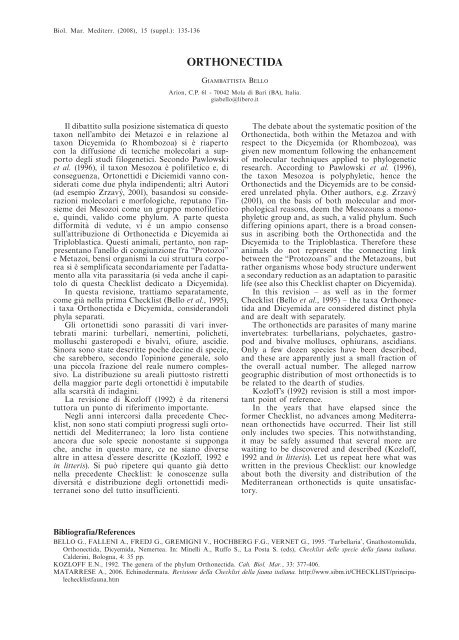ORTHONECTIDA - SIBM
ORTHONECTIDA - SIBM
ORTHONECTIDA - SIBM
- TAGS
- orthonectida
- sibm
You also want an ePaper? Increase the reach of your titles
YUMPU automatically turns print PDFs into web optimized ePapers that Google loves.
Biol. Mar. Mediterr. (2008), 15 (suppl.): 135-136<strong>ORTHONECTIDA</strong>Giambattista BelloArion, C.P. 61 - 70042 Mola di Bari (BA), Italia.giabello@libero.itIl dibattito sulla posizione sistematica di questotaxon nell’ambito dei Metazoi e in relazione altaxon Dicyemida (o Rhombozoa) si è riapertocon la diffusione di tecniche molecolari a supportodegli studi filogenetici. Secondo Pawlowskiet al. (1996), il taxon Mesozoa è polifiletico e, diconseguenza, Ortonettidi e Diciemidi vanno consideraticome due phyla indipendenti; altri Autori(ad esempio Zrzavý, 2001), basandosi su considerazionimolecolari e morfologiche, reputano l’insiemedei Mesozoi come un gruppo monofileticoe, quindi, valido come phylum. A parte questadifformità di vedute, vi è un ampio consensosull’attribuzione di Orthonectida e Dicyemida aiTriploblastica. Questi animali, pertanto, non rappresentanol’anello di congiunzione fra “Protozoi”e Metazoi, bensì organismi la cui struttura corporeasi è semplificata secondariamente per l’adattamentoalla vita parassitaria (si veda anche il capitolodi questa Checklist dedicato a Dicyemida).In questa revisione, trattiamo separatamente,come già nella prima Checklist (Bello et al., 1995),i taxa Orthonectida e Dicyemida, considerandoliphyla separati.Gli ortonettidi sono parassiti di vari invertebratimarini: turbellari, nemertini, policheti,molluschi gasteropodi e bivalvi, ofiure, ascidie.Sinora sono state descritte poche decine di specie,che sarebbero, secondo l’opinione generale, solouna piccola frazione del reale numero complessivo.La distribuzione su areali piuttosto ristrettidella maggior parte degli ortonettidi è imputabilealla scarsità di indagini.La revisione di Kozloff (1992) è da ritenersituttora un punto di riferimento importante.Negli anni intercorsi dalla precedente Checklist,non sono stati compiuti progressi sugli ortonettididel Mediterraneo; la loro lista contieneancora due sole specie nonostante si suppongache, anche in questo mare, ce ne siano diversealtre in attesa d’essere descritte (Kozloff, 1992 ein litteris). Si può ripetere qui quanto già dettonella precedente Checklist: le conoscenze sulladiversità e distribuzione degli ortonettidi mediterraneisono del tutto insufficienti.The debate about the systematic position of theOrthonectida, both within the Metazoa and withrespect to the Dicyemida (or Rhombozoa), wasgiven new momentum following the enhancementof molecular techniques applied to phylogeneticresearch. According to Pawlowski et al. (1996),the taxon Mesozoa is polyphyletic, hence theOrthonectids and the Dicyemids are to be consideredunrelated phyla. Other authors, e.g. Zrzavý(2001), on the basis of both molecular and morphologicalreasons, deem the Mesozoans a monophyleticgroup and, as such, a valid phylum. Suchdiffering opinions apart, there is a broad consensusin ascribing both the Orthonectida and theDicyemida to the Triploblastica. Therefore theseanimals do not represent the connecting linkbetween the “Protozoans” and the Metazoans, butrather organisms whose body structure underwenta secondary reduction as an adaptation to parasiticlife (see also this Checklist chapter on Dicyemida).In this revision – as well as in the formerChecklist (Bello et al., 1995) – the taxa Orthonectidaand Dicyemida are considered distinct phylaand are dealt with separately.The orthonectids are parasites of many marineinvertebrates: turbellarians, polychaetes, gastropodand bivalve molluscs, ophiurans, ascidians.Only a few dozen species have been described,and these are apparently just a small fraction ofthe overall actual number. The alleged narrowgeographic distribution of most orthonectids is tobe related to the dearth of studies.Kozloff’s (1992) revision is still a most importantpoint of reference.In the years that have elapsed since theformer Checklist, no advances among Mediterraneanorthonectids have occurred. Their list stillonly includes two species. This notwithstanding,it may be safely assumed that several more arewaiting to be discovered and described (Kozloff,1992 and in litteris). Let us repeat here what waswritten in the previous Checklist: our knowledgeabout both the diversity and distribution of theMediterranean orthonectids is quite unsatisfactory.Bibliografia/ReferencesBELLO G., FALLENI A., FREDJ G., GREMIGNI V., HOCHBERG F.G., VERNET G., 1995. ‘Turbellaria’, Gnathostomulida,Orthonectida, Dicyemida, Nemertea. In: Minelli A., Ruffo S., La Posta S. (eds), Checklist delle specie della fauna italiana.Calderini, Bologna, 4: 35 pp.KOZLOFF E.N., 1992. The genera of the phylum Orthonectida. Cah. Biol. Mar., 33: 377-406.MATARRESE A., 2006. Echinodermata. Revisione della Checklist della fauna italiana. http://www.sibm.it/CHECKLIST/principalechecklistfauna.htm
















